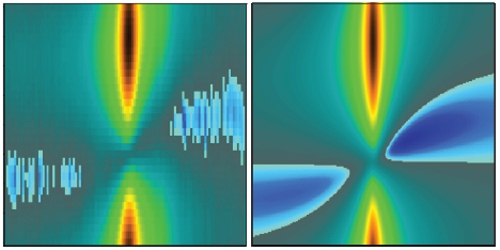Researchers from the Lawrence Berkeley National Laboratory (Berkeley Lab) of the U.S. Department of Energy and the University of California (UC) Berkeley have for the first time directly observed distinctly quantum optical phenomena, namely amplification and squeezing, in an optomechanical system.
 Berkeley Lab researchers directly observed quantum optical effects -- amplification and ponderomotive squeezing -- in an optomechanical system. Here the yellow/red regions show amplification, the blue regions show squeezing. On the left is the data, on the right is the theoretical prediction in the absence of noise. (image courtesy of Stamper-Kurn group)
Berkeley Lab researchers directly observed quantum optical effects -- amplification and ponderomotive squeezing -- in an optomechanical system. Here the yellow/red regions show amplification, the blue regions show squeezing. On the left is the data, on the right is the theoretical prediction in the absence of noise. (image courtesy of Stamper-Kurn group)
The study findings pave the way to several technological advancements such as improved sensitivity of gravitational wave detectors and low-power quantum optical devices. For this study, the researchers used their innovative optical trapping system that provides a cluster of ultracold atoms. Their microfabricated atom-chip system provides a magnetic trap to capture a gas containing thousands of ultracold atoms. This ultracold atom cluster ensemble is then shifted into an optical cavity (Fabry-Pferot) in which it is confined in a one-dimensional optical lattice created by near-infrared (850 nm wavelength) light which resonates with the optical cavity. A second light beam is utilized as pump/ probe.
Daniel Brooks, one of the researchers and part of Dan Stamper-Kurn's research team, stated that the integration of high-finesse cavities and confined cluster of ultracold atoms with an atom chip enabled the researchers to explore and manipulate the standard and quantum interactions between photons and the atom ensemble’s internal and external degrees of freedom. Unlike typical solid-state mechanical systems, the researchers’ optically levitated ultracold atom ensemble is separated from its environment, causing quantum radiation-pressure fluctuations to largely drive the ensemble’s motion.
In the study, a low-powered pump/probe beam entering the optical cavity was first subjected to classical light modulation by the researchers in order to illustrate that their system acts as a high-gain parametric optomechanical amplifier. The researchers then turned off the classical drive and plotted the response to vacuum fluctuations. This allowed the researchers to observe the squeezing of light by its interplay with the vibrating ensemble and the atomic movement triggered by the light's quantum fluctuations. Amplification and squeezing interplay, which is also known as ‘ponderomotive force,’ have been sought-after objectives of optomechanics research.
The study findings differ substantially from standard linear model predictions. This proposes that a nonlinear optomechanical hypothesis must explain the Berkeley team's findings that optomechanical interactions create non-classical light. Stamper-Kern's research team is planning further research involving two ensembles of ultracold atoms within the optical cavity. Brooks explained that with a two ensemble setup, one ensemble would be accountable for the optomechanical interplay for squeezing the radiation-pressure fluctuations, while the second ensemble could be explored to measure the squeezing within the cavity.